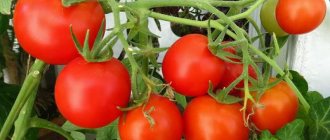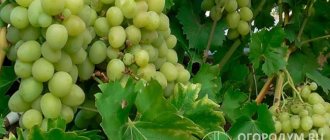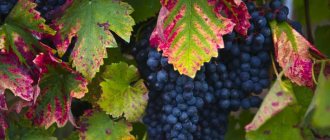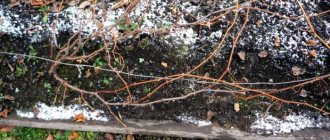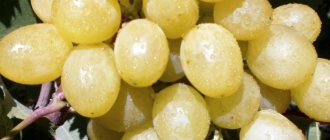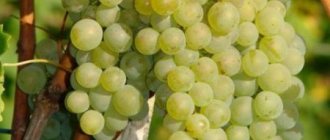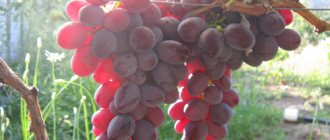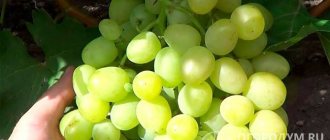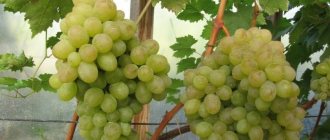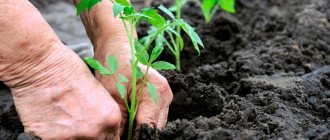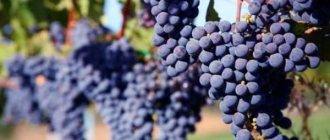Varieties and their overall productivity
The main characteristic of the variety is its yield. The description of any variety indicates which category it belongs to: low-yielding, medium-yielding or high-yielding.
The most productive varieties: Arcadia, Athos, Byzantium, Gourmet, Kishmish and other varieties with a bunch weight of 1 - 2.5 kg. On average, 10–25 kg of fruits are collected from a bush.
Low-yielding varieties produce up to 5 kg per bush, medium-yielding varieties - 5 - 9 kg.
Factors affecting fruiting
Place
The choice of planting location affects how comfortable the seedlings will feel in the ground, their survival rate and the quality of the future harvest depend.
First of all, you need to pay attention to the soil and planting site. The grapes are not whimsical and grow on any soil except saline
The best place for developing a vineyard is the southern or southeastern side of the plot. It is not recommended to plant in lowlands, as cold air masses accumulate there, and there is a risk of frostbite during the frost period. The best place is on slopes protected from cold northern winds with the least likelihood of soil freezing. The vineyard feels great near fences and walls of buildings. The optimal arrangement of rows is considered to be north - south. In this case, the bushes gain access to the sun's rays from both sides. Uniform and adequate lighting will help the plant gain the nutrients it needs for growth and development. With this planting orientation, it is recommended to leave about 2 meters between rows. This distance is sufficient for the free development of the bush and the formation of the necessary shade for protection from the harmful effects of direct sunlight. In other cases, 2.5 - 3 meters are left between the rows.
Time
Planting time - air temperature and weather conditions on the day of planting affect the ability of seedlings to take root and ensure further favorable development.
The ideal time to start planting is considered to be the days when the soil temperature has reached a stable value of +15 degrees Celsius. The higher the temperature, the faster the seedlings take root and form a powerful root system.
Trimming
Proper pruning is the key to the formation of a strong bush that can provide the clusters with the necessary nutrients.
In the first year of growth, all efforts should be directed to the development of two main shoots. In early September, it is recommended to pinch their tops and remove the young stepsons. After full ripening, in early December, the vines are pruned into 3-4 buds. In subsequent years, the resulting stepsons are pinched over the second leaf, and the upper part with inflorescences is removed.
Top dressing
Periodic feeding of the bush with fertilizers and watering will allow the plant to restore the nutrients spent in large quantities on the ripening of the bunches.
In spring and early summer, it is recommended to apply nitrogen and phosphorus fertilizers together for better efficiency, and add organic fertilizers in the fall. Fertilizers are applied to a depth of 40 - 60 cm within a radius of 1 meter. You can provide nutrients not only to the roots, but also to the foliage. Foliar fertilizers are applied by spraying the leaves and are absorbed instantly. They are often combined with substances to protect against fungal diseases and rot.
If you want to get fruitful grapes as soon as possible, you can resort to some alternative methods.
- Healthy grape cuttings can be planted in a plastic container in February. By May they produce a meter-long shoot that can be safely planted in open ground. After the cutting takes root and produces the first stepsons, they are pinched out, and the first harvest can be obtained the following year.
- The easiest way is to buy a ready-made three-year-old seedling. It is planted in the soil, and excess shoots are carefully removed so as not to harm the plant. This method makes it possible to obtain the first mature bunches already in the first year from the moment of planting and to test the acquired variety.
Another main question tormenting gardeners is to find out how many years grapes bear fruit. From the moment of full fruiting to the aging and death of the bush, it takes from 9 to 26 years, it is possible that the period may increase depending on the characteristics of the variety and its care. When a crop is propagated by cuttings, it will produce a harvest within 50-150 years.
Today there are many varieties of grapes with different properties, taste and commercial qualities. The only thing that remains unchanged is people’s love for this culture and devotion to the ancient traditions of grape cultivation. Become part of this exciting process and choose varieties that you will truly enjoy from the process of growing and consuming.
What does productivity depend on?
The yield of grapes depends on the combination of many factors, which will ultimately give either an excellent harvest, or the result is far from your expectations. If we highlight the main criteria for good fruiting of grapes, then these include:
- Correct choice of planting material. You can plant grapes either with ready-made seedlings or grow the cuttings yourself until they are ready to be planted in open ground.
- Planting grapes. There are many nuances here that affect the final result, from the distance between the bushes to the depth of the planting hole.
- Choosing the right place and time of landing.
- Properly carried out annual pruning, with the correct formation of the bush and taking into account the adjustment of the load on the bush.
- High-quality preparation for winter and timely treatment of diseases.
- Watering and fertilizing.
- Plant age.
- Select a variety that suits your region. If you get the wrong variety, you may never see ripe grapes.
How many years does it take for grapes to grow? Arcadia
The second name of this variety is Nastya. If you provide the shrubs with proper care, you can get high yields. The berries on the vines are large and have a pleasant nutmeg aroma. The characteristics of the variety include excellent adaptation to various climatic zones, and sudden temperature changes do not harm the crop.
Arcadia
The positive aspects of Arcadia are the following features:
- early ripeness, from the moment the flowers appear until the first tassels ripen, approximately 120 days pass;
- large berries: one grape can weigh about 15 g. The color of technical ripeness of the berries is white, light yellow; biological ripeness is indicated by the amber color of the grapes;
- the peel is thin, has a whitish waxy coating, inside the berries there is a fleshy juicy pulp.
How long does this grape variety grow before fruiting? It all depends on how the landing was carried out. If cuttings were selected, then the second year is characterized by the appearance of signal clusters, which are recommended to be left in the amount of 2 so that the berries do not overload the bushes. But from the third year, full fruiting of the crop begins.
To get a good harvest in the early stages, you need to take into account many factors, as well as provide the grapes with proper care. We are talking about the correct selection of location, watering, pruning and treatment against diseases and pests. Only after this can the gardener count on reward for the work done.
By region
Bunch of grapes
In the climatic conditions of the Moscow region, it is recommended to grow very early grape varieties, which have a ripening period of 110 to 115 days, since later varieties will not have time to produce a harvest before the first frost.
For cultivation in Siberia, biologists have developed frost-resistant varieties that can withstand up to 40 degrees below zero.
Grapes are planted when the soil warms up to 13-15 degrees. Before planting, fill the hole with hot water to prepare the soil. The seedlings are well covered until the threat of cold weather disappears.
In central Russia, it is recommended to grow early varieties (Crystal, Yantar, Vostorg) and medium-ripening varieties (Alexander, Bashkirsky). In addition, technical varieties (Alievsky, Ermak) and universal varieties are also suitable for growing under these conditions.
Grape care. Grapes and their care: recommendations for beginners and experienced
The desire to have beautiful and well-groomed grapes arises among many amateur gardeners. Many people, when purchasing a summer cottage or moving to the private sector, first of all plant grape vines. Unfortunately, not knowing how to properly care for grapes, many amateurs lose seedlings by the first year. In some cases, when the variety is strong, it simply turns wild and serves as decoration. Therefore, we propose to consider this issue in more detail, for each category: for those starting to live in the private sector or for those who have recently purchased a summer cottage. And for experienced gardeners who want to start growing grapes.
Many gardeners have a desire to have beautiful and well-groomed grapes.
For newbies
Before we talk about all the nuances of planting and caring for the plant. We recommend that you familiarize yourself with ten tips for beginners. The rules that will be outlined below will help you grow beautiful, and most importantly, prolific grapes:
Following the rules will help you grow beautiful grapes
- Be careful when choosing your landing site. Before purchasing grapevine seedlings, you need to check the capabilities of the selected variety. Will he be able to adapt to the conditions and external factors of your region of residence? Next, we choose the place where our grapes will grow. The fact that the place should be bright and warm is not even discussed. It is advisable that the bush is located in the southern or southwestern corner of your summer cottage. Think about what will protect the sprouts in autumn and winter during wind and heavy rains. It would be great if the grapes were planted near some kind of fence. Planting the bush should be away from tree crowns. They only interfere with the development of the cutting. The roots will not allow the young plant to receive all the moisture or nutrients coming from the soil.
- Each variety has a peculiarity in its behavior and is demanding on the soil. For example, many Asian or European species prefer alkaline soil. If the variety is American, the soil should be acidic. Do not plant grapes close to sources of moisture. The roots can rot due to its excess.
- Choose a variety responsibly. Familiarize yourself with all the types of grapes that may grow in the region where you live. What are their taste qualities, what kind of harvest is possible, etc. Some varieties are able to live in many climatic conditions, winter quietly at -20: Lidia, Isabella, Arcadia, Moldova.
- Grapes are a heat-loving plant, so it is necessary to create conditions so that they feel comfortable. To do this, cover it with stones, make a partition, cover the soil with additional materials, and plant it where there is most sun all year round. Thus, even in autumn the seedlings will be warm and cozy.
- After planting the grapevine in the soil, it is recommended to make a stove from bottles: only glass ones are used. They must be immersed upside down. When the sun hits them, it heats the glass, which, in turn, transfers heat to the roots.
- Every seedling, and then a grape bush, needs sun. When planting them, watch the distance. It should not be less than 1 meter. Since the grape bush will grow and expand, the neighbors simply will not have access to normal light. As a rule, the bushes disappear.
- Watering.
Grapes, oddly enough, and not surprisingly, are not a fan of large amounts of moisture. Everything should be in moderation. The most important year is the first year. Here you cannot oversaturate the soil or, conversely, not provide the required amount of water to the roots. Grape breeding specialists recommend making a hole in a circle at a distance of 25–30 cm from the cuttings. Pour water into it, which can nourish the roots. Grapes do not like a lot of moisture - Already in the fall, in the first year of your grape bush’s life, it will be necessary to do pruning. If everything is done correctly, the development of the vine will be good. According to the Groyo method, it is necessary to leave three shoots so that buds can form in the spring. With each pruning their number will increase.
- By the beginning of the second year of their life, the grapes begin to stretch much faster, so do not skip the garter. It is best to do it at an angle of 45 degrees. Already in the process of harvesting, the garter will be more extensive and have a different design for fastening.
- What you need to know and monitor this constantly is spraying against fungus and other diseases. By not spraying on time, you doom the grape bush to death. There are many ways to spray and treat leaves. You just have to choose the one that is more suitable for you.
When does the harvest begin?
The most important question that interests all gardeners is: when do grapes begin to bear fruit after planting as seedlings? If the rules of agricultural technology are observed, grapes begin to bear fruit in the third and even in the second year of planting.
Important! It is not recommended to leave flowers in the first year of grape growth, as this will weaken the further development of the bush.
To obtain a harvest in a short time, it is advisable to purchase seedlings with a closed root system. The vine growth should be mature, approximately 5 to 7 mm thick. If such a plant is planted in the fall and carefully protected from the winter cold, it will bloom next year.
Two or three year old seedlings take root more difficult , but with proper care they begin to bear fruit in the year of planting. The fruits ripen on them for 3 months.
By storing one flowering cluster on each shoot, the fruit ripening period is reduced by 10 days.
Grape seedling
When planting grape cuttings, fruiting occurs 4 years after the first roots appear.
If cuttings are planted in the ground in the spring before the sap begins to flow along the stems, the plant will take root faster, but during the summer it will not have time to grow enough to bear fruit next year. It will bloom in 2 years.
If the cuttings are planted in high pots in February, then in the warmth they will give an increase of 45-50 cm by the beginning of summer. When they are transferred to a permanent place in open ground, flowers will appear in the second year, but a full harvest will only be obtained in the fourth year.
Subtleties of care
How many years does a grapevine live? The period depends on the care of the shrubs. Excessive amounts of water lead to numerous growths, and there is no longer enough strength to produce fruits. If the vines do not ripen, the buds will freeze in winter. Insufficient watering also negatively affects the well-being of grapes, and therefore moderation is recommended.
When to water tomatoes after planting
During watering, you can apply various fertilizers. Mineral and organic fertilizers are most often used. Organic matter is added once every 3 years, as well as phosphorus and potassium. In the spring months they limit themselves to compost, and with the onset of autumn they add manure.
Important! In spring, it is recommended to feed the grapes before winter shelters are removed from the bushes.
For plant health, fertilizing is applied three times during the growing season:
- the first time in the spring months before flowering begins;
- the second time, so that the ovaries are well formed before the formation of flowers;
- the third time before the fruits begin to ripen.
For what year?
Biologists have found that from the beginning of fruiting to the death of the bush, it takes from 10 to 25 years. Depending on the variety and proper care for it, this period can be increased.
First
In the first year after planting, it is necessary to provide the plant with proper care with careful adherence to agricultural technology conditions. The main task in the first year is to grow a healthy vine and carry out high-quality pruning. These conditions determine how many years it will begin to bear fruit and whether there will be a harvest at all in the following years. At this stage of development, the flowers are cut off.
Second
In the second year, the vine begins to bear fruit, but since two-year-old grapes have 3-4 branches, the grape clusters will be large (depending on the variety), but their number will be less than that of an adult vine. With good care, you can achieve a harvest that is 2 times less than that which the vine will ripen in subsequent years.
Third
In the third year, the bush has already become stronger, the root system has grown, and fruiting will be in accordance with the yield indicators of each variety. On average, the harvest will be 15-20 kg per bush.
Yield growth increases every year during the 8-9 years of fruiting of the bush.
After this, yields gradually decrease until the bush is rejuvenated.
Fruiting age of grapes
At what age do grapes begin to bear fruit?
If you believe the reference books, then in four years. But this is using industrial technology, when after planting a seedling, one shoot is left. In the fall it is cut into two buds, from two buds in the second year two shoots are obtained, and so on.
That is, they form the bushes slowly. This method is not suitable for gardeners at all. Therefore, winegrowers try to get the first bunch in the second year. And normal fruiting occurs on the third
It's all in the bottle
Industrial shaping is used mainly in non-irrigated vineyards. There the bush gradually gains strength with minimal care. And winegrowers speed up the process, achieving the first harvests very simply.
In February, cuttings are planted at home in plastic bottles. By the time they are planted in open ground in May, they have already gained almost a meter of growth. Next, they pinch a little, and with the help of stepchildren, they get two ripened shoots by autumn.
A good buy
But there is an easier way - buy a three-year-old seedling. He goes through the transplant painfully, but still throws away the brushes that he laid in the nursery or school. You just need to remove the excess ones so as not to weaken the plant too much, and in the first year you can try the berries. This is also convenient because you can immediately check the variety...
Berries from cuttings
Often, planted cuttings can throw out brushes. It is the formed buds that perform “miracles”. The bunches definitely need to be removed. But if you are sure that the cutting has already caught its roots in the ground, then leave a small part of the bunch, and after pollination, two or three berries on the bunch to check the variety. Of course, normal fruiting will occur in two years.
Diseases and pests
Each disease or pest significantly reduces yield. Let's briefly look at the main ones:
- When grapes are affected by downy mildew, the flowers and ovary dry out; with ordinary powdery mildew, the fruits burst and rot.
- Anthracnose and black spot cause blackness and death of bunches.
- Fruits affected by cercospora blight turn blue, wrinkle and fall off.
- With root rot, the bush itself dies.
- With gray rot, a fluffy coating appears on the grapes and foliage. The berries fall off.
- Phylloxera (grape aphid) is a very dangerous pest. She sucks the juices from the roots, the bush dies.
- The felt mite envelops the fruits in felt, and the growth of the bush slows down.
- Caterpillars of leaf rollers and mealybugs eat leaves and fruits.
Attention! It is believed that grapes grown in the southern regions are more susceptible to diseases and pests.
Violations committed in the dosage of fertilizing
Professionals recommend the following feeding scheme:
- autumn is the time for organic fertilizers, and spring for nitrogen fertilizers, and first take 50% of the recommended dose;
- complex preparations are applied before flowering and after ovary;
- ammonium nitrate is added during the ripening of the berries;
- Potassium is added in the fall, before harvest. It increases frost resistance and helps prepare the bush for winter.
Fertilizers are applied under the bush, to the roots, to a depth of 0.5 meters. To do this, use pipes dug into the ground.
If the bushes are “overfed” by applying nitrogen-containing fertilizers, the plant itself begins to develop intensively - leaves and branches grow luxuriantly, and the number of flowers and ovaries decreases, fewer fruit clusters are produced. In addition to the decrease in yield, other important abilities of the plant are weakened: cold resistance, resistance to various types of diseases .
When fertilizing with fertilizers, consider the advice of professionals:
- It is advisable to apply organic fertilizers in the fall, while simultaneously reducing the amount of nitrogen fertilizers in the spring cycle by 50%.
- In spring and early summer, two additional feedings are also performed with a complex preparation: before flowering, before the plant sets fruit,
- after the berries have set.
It is worth adding that with proper feeding, the flowers and ovaries will stop falling off en masse, the berries in the bunch will ripen evenly, and the shape of the grapes will be the same.
Errors
At first time
To obtain the first harvest, great importance is given to pruning and shaping the bush to adjust the correct load on the vine. The bush quickly becomes overgrown with excess green mass and young shoots, which consume 90% of the nutrients. The size and quality of the bunches decreases, the harvest will be poor.
If all the growing points on the shoots are cut off (all the stepsons are pinched), wintering points begin to grow, which should bear fruit next year, then next year the harvest will be meager.
With frequent and abundant watering, the green mass will begin to actively grow, the ripening of the bunches will be delayed, and the sugar content of the fruit will decrease. Therefore, in the second half of summer, when the berries ripen, watering is reduced.
All in all
If grapes are planted on the north side of the house or in the shade of trees, then the vine will reach towards the light, the bush itself will grow weak, rare flowers will fall off and there will be no harvest.
A seedling with a shallow planting will have roots that freeze in the winter and will dry out in the summer.
When the leaves dry out, you should not use abundant watering; this sign may be the beginning of a disease or a lack of nutrients. We need to figure out the cause and eliminate it.
Planting grapes in a garden plot is not difficult even for an inexperienced gardener. The main thing is to follow the necessary rules of agricultural technology. Their further growth, quality and quantity of the future harvest depend on how comfortable the planted bushes feel.
How to make grapes bear fruit. Lack of flowering and fruiting in grapes
For an experienced gardener, growing grapevines is not a difficult task. The longevity of this plant allows you to take the right actions to obtain a generous harvest. But there are times when the grapes do not bloom. Then the cause should be identified and care adjusted.
Lack of flowering and fruiting in grapes
Rules for growing grapes
To get the desired result, the gardener must follow several rules for growing vines. It is important to select seedlings appropriate to the region. Purchase healthy and technically undamaged plants that have at least 3 root shoots and a half-meter shoot. If there are no strange spots or mechanical damage on the vine, it will take root.
Planting material is added in drops when bud growth is stopped: in early spring or late autumn. If you plan to plant several bushes, they are placed at a distance of 1.5 m from each other.
During planting, all stages are followed, starting with choosing a location, digging and fertilizing the hole, and ending with the construction of a drip irrigation system and the installation of supports. Throughout the entire period of growth and development, they follow the watering regime, be sure to trim off excess branches, treat the vine with fungicides against pests, and provide protection from frost in the cold season.
No flowering
If all recommendations for caring for grapes are followed, pay attention to how many bushes ignore the flowering period. Next, they look at the possible causes of the disease:
- Excess water in the soil layer leads to the formation of specific peas on the ovaries during flowering, thinned out formation of clusters, shedding of flowers and already formed ovaries. Moisture does not allow enough air to pass into the upper layers of the soil, which leads to gradual chlorination of the leaves, which cease to produce substances necessary for the growth of the vine, and then to the death of the roots.
- High air humidity also negatively affects the quality and quantity of ovaries. Heavy frequent rains during the flowering period of grapes become an obstacle to pollination, especially for functionally female varieties.
- Under the influence of winter cold or spring frosts, the first fruitful shoots die. The grapes have replacement buds that bloom if the central ones die. But these second shoots bloom much weaker or produce only leaves, which also leads to the absence or significant reduction of the harvest.
- Improper pruning can lead to a lack of flowers on the bushes. Grapes produce special fruiting shoots only on annual vines; they differ from the rest in color. If you cut these shoots too short or get rid of them altogether, the plant will produce only leaves from the still dormant secondary buds, so you should limit yourself to reducing the shoots to 8-10 buds.
Review of early varieties
When planting a vineyard, focus on crop varieties that are distinguished by early fruiting. The following varieties boast these characteristics.
The bush is vigorous, with well-ripening vines. Each shoot forms 2-4 inflorescences. Clusters weighing more than 3 kg have pronounced branching and a beautiful conical shape. The weight of one fruit is 4-5 g. Delicate pink fruits with dense juicy pulp with a nutmeg flavor. From one bush you can get 4-6 kg of berries.
The variety is high-yielding, fruitful, frost-resistant, and will be a good decorative addition to the site.
Long
A universal variety that ripens at the end of September. The growth vigor of the bushes is great. A bunch weighing 200 g has a conical shape and a dense structure. The berry weighs up to 3 g, oval, yellow-green in color. The pulp is juicy with a pleasant taste.
The disadvantage of the variety is considered to be instability to frost and fungal infections, and therefore requires a set of measures to protect against diseases and cold.
Isabel
Bushes of medium growth vigor, form medium-sized brushes, weighing 2-2.5 kg and cylindrical in shape. The grape fruits weigh 3 g, are round, black-violet in color with a thick coating of bluish-gray color. The skin is dense and durable. The pulp is pale green, sweet and sour with a flavor reminiscent of strawberries. Harvest occurs at the beginning of October. The first fruiting is observed in the 3rd year after planting the seedlings.
The variety is valued for its taste, low calorie content, high yield, and unpretentiousness in growth. A universal variety, it can be used both fresh and for the production of high quality wine and raw materials for various home preparations.
Kishmish
The bush forms shoots of great growth vigor, the vine matures at 2/3 of its length. The crop has large clusters that can weigh up to 1 kg. The small pink berries have a characteristic waxy coating and thin skin. Distinctive features of this variety are its sweet taste and the absence of seeds.
High yield and disease resistance make the variety attractive for cultivation.
Muscat summer
Grape bushes have the ability to reach 3 m in height. The plant is decorated with clusters of cylindrical shape, loose, fruits weighing up to 8 g, colored amber with a white tint. The pulp is juicy and sweet.
The variety is popular because of its yield, 40 kg of berries can be cut from one bush, early ripening and resistance to diseases and pests.
Noble
Grape bushes of great growth vigor with clusters in the shape of a cone, medium density, moderate looseness, weighing up to 700 g. Fruits weighing up to 16 g, green-yellow in color with dense skin that is not felt when eaten. The pulp is characterized by meatiness, juiciness and a pleasant nutmeg taste.
Fruiting is observed in the 3rd year after planting.
Augustine
A vigorous bush of grapes, forming conical clusters, weighing up to 600 g. The fruits are elongated oval in shape, amber in color, and when fully ripe, acquire a blush on the sides. The weight of one fruit is 7 g. The pulp is dense, fleshy with a harmonious sweet taste without a pronounced aroma.
Augustine does not require special climate conditions and bears fruit well and consistently even in the most unfavorable areas.
Alyoshenka
The grape bush is characterized by powerful growth force. The bunch is distinguished by its elegance and loose structure. The weight of the bunch ranges from 0.8 to 2.7 kg.
The berries are oval-shaped, amber in color with a light white waxy coating. The weight of each berry is 4-5 g. Crispy, juicy pulp with a pleasant taste.
Harvest occurs at the end of July. From one bush you can get approximately 25 kg of quality harvest.
Early Harvest Methods
Planting three-year-old seedlings with proper care will allow you to get an early harvest the following year. Growing seedlings in a bottle from February accelerates the formation and ripening of a full-fledged vine, capable of bearing fruit in the second year.
Unlike growing grapes on an industrial scale, you don’t have to subject young plants to very short pruning on your own plot and allow them to bloom in the 2-3rd year. Regular watering and fertilizing stimulate accelerated growth of the root system and ripening of the vine, in contrast to non-irrigated vineyards of large farms. This allows you to get the harvest 1-2 years earlier.
{SOURCE}
How to plant grapes correctly
When the hole is ready and the plant is hardened, start planting. Remove the grapes from the package along with the earthen lump. Place the seedling in the hole so that the zone of root formation (heel of the cutting) is located 35-40 cm below ground level. Conventionally, this place can be taken as the center of the container where the seedling was located.
If the seedling is too long and cannot be planted vertically at the correct depth, place it at an angle, first pouring soil on one side of the hole.
At the end of planting, fill the plant with soil 5 cm below the “eye”, compact it thoroughly with your hands so that there are no voids. Water the seedling with 1-2 buckets of warm water. Wait until it is absorbed and completely fill the hole with soil, but do not compact it. The soil must remain loose so that there is good air exchange, so there is no need to trample it. But mulching is worth doing, because... it will prevent the formation of an earthen crust and reduce the evaporation of moisture.
Many gardeners wonder at what distance to plant grapes in a row. We answer: it is best to maintain a distance of 1-1.5 m between plants. If there are a lot of seedlings, you can dig not holes, but a trench 40-80 cm deep. Support for the grapes is also necessary so that the vine develops correctly. Use pegs, pipes, etc. as a temporary solution. In the future, it is worth installing a trellis, which will allow the bush to form perfectly and make it easier to care for.
